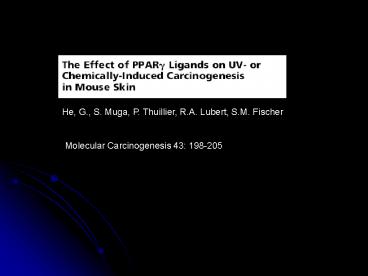Molecular Carcinogenesis 43: 198-205 - PowerPoint PPT Presentation
1 / 17
Title:
Molecular Carcinogenesis 43: 198-205
Description:
He, G., S. Muga, P. Thuillier, R.A. Lubert, S.M. Fischer Molecular Carcinogenesis 43: 198-205 What is PPAR-g? Peroxisome proliferator-activated receptor-gamma: member ... – PowerPoint PPT presentation
Number of Views:171
Avg rating:3.0/5.0
Title: Molecular Carcinogenesis 43: 198-205
1
He, G., S. Muga, P. Thuillier, R.A. Lubert, S.M.
Fischer
Molecular Carcinogenesis 43 198-205
2
What is PPAR-g?
Peroxisome proliferator-activated receptor-gamma
member of the steroid nuclear hormone receptor
superfamily Three types of PPAR, encoded by
separate genes a, b, g, each with own set of
prefered ligands PPAR-g ligands Thiazolidone
class of drugs (ciglitazone, triglitazone,
rosiglitazone (Avandia- GSK, oral hypoglycemic
drug) 15-dPGJ2 Fatty acids PPAR-g has a role
in adipocyte differentiation and fat metabolism.
3
Does PPAR-g have a role in carcinogenesis?
Inhibit cancer PPAR-g activators can inhibit
growth of breast cancer cell lines in vitro by
increasing sensitization to apoptosis. Reported
to Inhibit in vivo growth in xenogeneic system
(nude mice) and various in vivo cancer
models. Promote cancer Two reports that
thiazolidone drugs promote colon cancer in animal
models. Lisas data (J. Nutrition, 2005) is
inconclusive in vitro data indicates that PPAR-g
inhibits tumor growth. In vivo data is another
story- leans towards being pro-tumor (still a lot
of questions). What about skin cancer?
4
PPAR-g in skin cancer
PPAR-g /- mice are more susceptible to
DMBA-induced skin papilloma development compared
to PPAR-g / (wt) mice (Nicol et al,
Carcinogenesis, 2004). In human skin, PPAR-g
associated with keratinocyte differentiation
supra-basal cells only (Westergaard et al, JID,
2001). In vitro, PPAR-g ligands inhibit growth
of cultured mouse keratinocytes. However, PPAR-g
protein was not detected in the keratinocytes
(He et al, JID,2004).
5
Effect of Dietary Rosiglitazone on UV Skin
Carcinogenesis
UV 3x/week for 15 weeks (90mJ/cm2 start, increase
10 weekly to 175mJ/cm2) Mice randomized to
rosi or rosi- diet weeks 15-29 (rosi 200ppm-
very high compared to what Lisa uses- 12mg/kg)
Tumors/mouse
mice with tumors
No difference
6
Effect of Topical Troglitazone on UV
carcinogenesis
UV 3x/week then topical treatment with 100mg
troglitazone or acetone
Tumors/mouse
mice with tumors
No significant effect
7
Effect of Dietary Rosi on DMBA/TPA skin
carcinogenesis
Tumors/mouse
FVB/n mice, shaved, 100mg DMBA, at 2 weeks,
3x/week treatment with 2.5mg TPA Mice randomized
to rosi or rosi- diet weeks 2-17 (rosi 300ppm-
very high compared to what Lisa uses- 12mg/kg)
mice with tumors
No significant effect
8
Effect of dietary Troglitazone on BrdU labeling
(epidermal proliferation)
2000ppm troglitazone for 1 week TPA or vehicle,
then inject with BrdU
Inhibits control proliferation, but not
TPA-induced proliferation
9
PPAR-g mRNA (Northern blot)
FVB/N
F fat Pprimary keratinocyte E epidermis W
whole skin T tumor
SKH
FVB/N
10
FVB/n 20X
FVB/n 40X
FVB/n (40X) From BrdU expt
FVB/n 40X
UV
UV Skin tumor
11
FVB/n 20X
FVB/n 40X
UV
UV skin tumor
UV Skin tumor
No section of normal SKH skin
12
Conclusions from this paper PPAR-g ligands did
not significantly alter skin tumor development
when used at 200-2000ppm
Lisa uses dietary Rosiglitazone and Fish oil to
activate PPAR-g In breast cancer Fish oil
protective, PPAR-g does not appear to be
protective (still trying to figure out whats
going on model specific (Her-2/neu Tg
mice) dose of Rosi (12mg/kg vs 200ppm) In human
studies, TGF-b induces PPAP-g and inhibits CTL
restimulation. Further, PPAR-g ligand ciglitazone
induces PPAR-g and alters APC function so that
CTL restimulation is inhibited (Kellys
expts) What about fish oil and Rosi in UV
inflammation and carcinogenesis?
13
(No Transcript)
14
(No Transcript)
15
fish
Fish rosi
16
17
Fatty acids (LA,DHA,EPA)
eicosanoids
Fatty acid derivatives
Thiazolidinediones (rosiglitazone)
RXR
PPAR-?
Breast cancer
HER-2/neu
RAR
Estrogen R Progesterone R
Cell proliferation, tumorigenesis
Fat metabolism
Adipocyte differentiation

